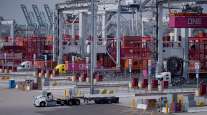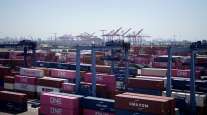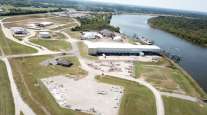Senior Reporter
Port Slowdown Affects Workers Who Rely on Cargo, Leaders Say

[Stay on top of transportation news: Get TTNews in your inbox.]
The nation’s ports are managing the intersecting crises of the COVID-19 pandemic, the resulting recession, and the lingering effects of a business downturn caused by the trade war between the United States and China. While they’re working through these challenges, port leaders are raising caution these declines could affect those whose employment relies on the flow of goods.
“When less cargo moves, there are fewer jobs, so whether it’s a truck driver, an electrician or a longshoreman, all of that is very concerning,” Eugene Seroka, the executive director of the Port of Los Angeles, said in an interview with Transport Topics Radio. “We’ve been hit with two tremendous shocks to the system — the trade policies with China and COVID-19 — and it’s caused cargo movement to go up and down with a lot of uncertainty.”
While various union contracts protect longshoremen — many of whom can be shifted into different positions within the system depending on freight movement — port staff are employees of the City of Los Angeles, Seroka noted. The port has 900 employees, some of whom could be furloughed if the economy doesn’t pick up, Seroka said. He added that his facility is operating at about 85% of capacity.
“Our budget has been cut; we have made priorities of regulatory, contractual work that must be done, but everything else is on the table as discretionary,” he said.

Connor
American Association of Port Authorities President Chris Connor delivered much the same message to Congress when he testified May 29 before the House Transportation and Infrastructure Committee’s subcommittee on Coast Guard and Maritime Transportation.
“Containerized cargo declined by 18% in the month of March [year-over-year],” he said. “Furthermore, ports have seen a significant increase in blank sailings or canceled vessel calls, resulting in revenue losses for port authorities. While data is still incoming for the months of April and May, the initial indications show declines of 20% to 25% [year-over-year].”
Over the next five years, the nation’s ports plan to spend nearly $155 billion in capital improvements, including dredging, installing cranes, improving access roads for trucks, and adding hundreds of miles of rail lines to create more intermodal facilities, he said. But Connor also noted that some of those plans could be jeopardized if the economy does not improve.

How can trucking companies adjust to ensure that essential freight keeps moving while protecting their workers from coronavirus? Host Seth Clevenger speaks with Lilli Chiu of Hub International and Dave Cox of Polaris Transportation. Hear a snippet, above, and get the full program by going to RoadSigns.TTNews.com.
“We’re beginning to see furloughs and layoffs in the port industry, and we’re also beginning to see that some ports are looking to forgo planning for an investment in capital improvement projects,” he said. “The implications of deferring or canceling investment in other capital improvement projects will be felt long after this pandemic and won’t bode well for American efficiency and logistics nor its competitiveness in global markets.”
As relations between Washington and Beijing deteriorate amid the finger-pointing over the COVID-19 pandemic, there are indications the phase one trade agreement between the U.S. and China could be in jeopardy. Bloomberg News reported that Chinese state-owned agricultural firms have been told to halt purchases of U.S. soybeans, which was a cornerstone of the deal. In the agreement, China promised to purchase an additional $200 billion in U.S. energy, manufacturing and agricultural products during the rest of 2020 and 2021.
Since 2018, the Trump administration has imposed $300 billion worth of tariffs on Chinese products entering the U.S. Seroka said if his facility and other ports are to recover some of the business they’ve lost, the tariffs need to be reduced or eliminated.
“We need to reverse these policies,” he said. “Weaponizing tariffs and using them to get after other political means have proven to be ineffective. The only ones who were paying the tariffs were the American companies that import the cargo from China.”

Seroka
Seroka added, “Even though these trade policies have hurt us, there is very little we can do with this administration today, and we must adapt, and it’s my belief we have to reinvent the Port of Los Angeles, become more reliant on exports, balance our trade and reduce our costs.”
Both Seroka and Connor agree it’s going to take more than a year before the ports return to the level they were at in 2017 and 2018. In 2018, the Port of Los Angeles set a record for cargo volume, processing 9.45 million 20-foot-equivalent containers.
“It’s going to take some time to recover from the depths that we’ve reached at this time,” Seroka said.
Connor added, “For ports, as for other industries, the future remains uncertain. At this stage of the pandemic, hope for a quick V-shaped recovery has been replaced by the realization of a longer battle ahead.”
Want more news? Listen to today's daily briefing:
Subscribe: Apple Podcasts | Spotify | Amazon Alexa | Google Assistant | More




